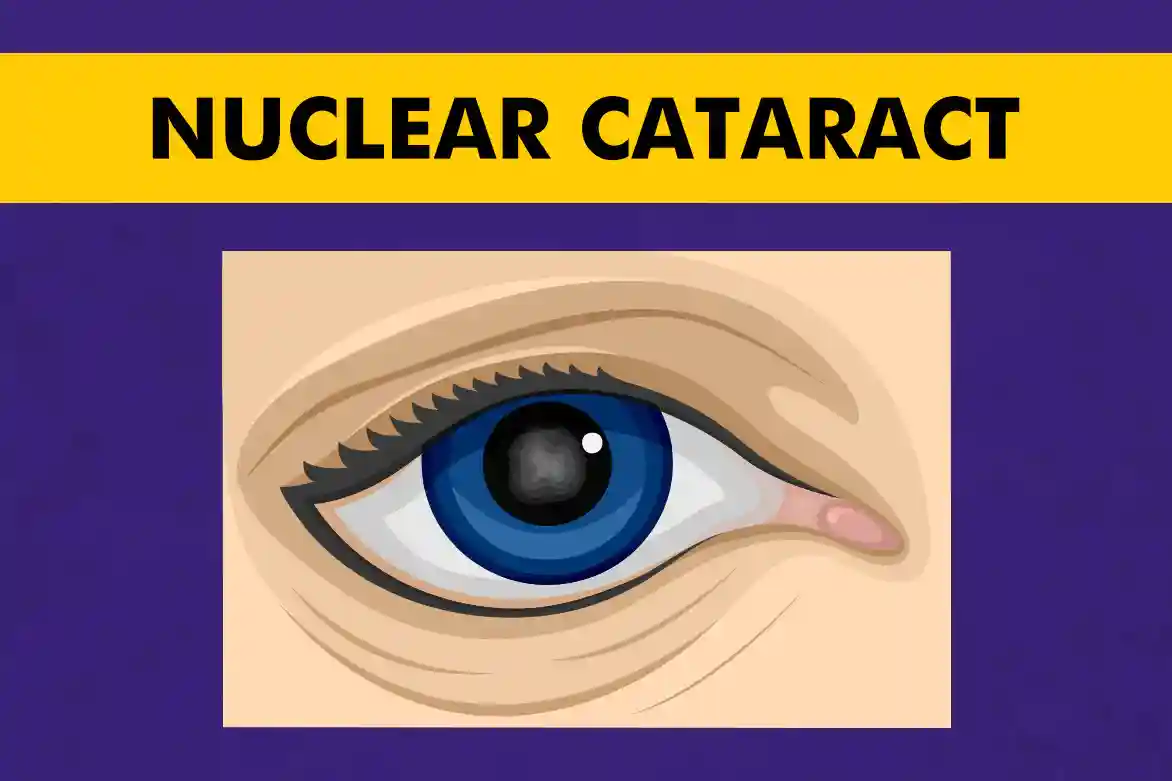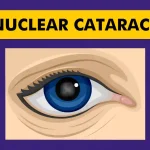Cataracts in general are a common age-related eye condition, but nuclear cataracts specifically occur in the nucleus of the lens. It is characterized by the clouding or opacity of the lens, which can lead to vision impairment. In this blog post, we will discuss the causes and treatment options for sclerosis cataracts.
In the following sections, we will explore the causes of nuclear sclerotic cataract, how they are classified, the risk factors associated with this condition, and the diagnosis and treatment options available. We will also discuss post-surgery precautions and lifestyle changes that can help prevent the development or progression of nuclear cataracts. Let’s dive in!
What Is a Nuclear Cataract?
A nuclear sclerotic cataract is a type of cataract that affects the central portion of the lens, known as the nucleus which can interfere with the passage of light and result in vision problems. As we age, the proteins in the lens of our eyes can start to break down and clump together, forming cloudy areas. These cloudy areas, or cataracts, can affect the clarity and sharpness of our vision. In the case of nuclear cataracts, the clouding occurs in the central part of the lens, which can make it difficult to see objects clearly, especially in dim light. It can cause vision to become progressively more blurred and can also lead to other symptoms such as difficulty seeing in low light or problems with color perception.
Symptoms of Nuclear Cataracts
Nuclear sclerotic cataracts can cause a range of symptoms that can gradually worsen over time, such as:
– Blurred or cloudy vision: The clouding of the lens can cause objects to appear hazy or blurry.
– Difficulty seeing in dim light: Sclerosis cataract can make it challenging to see clearly in low-light conditions, such as at night or in dimly lit rooms.
– Problems with color perception: The lens plays a crucial role in filtering and focusing light, and when it becomes clouded, it can affect the perception of colors.
– Increased sensitivity to glare: Nuclear cataracts can cause an increased sensitivity to bright lights or glare, making it uncomfortable to be in well-lit environments.
– Decreased contrast sensitivity: As the cataract progresses, it can affect the ability to distinguish between objects that have similar shades or colors.
If you are experiencing any of these symptoms, consult an eye care professional to determine the cause and appropriate treatment options.
Causes of Nuclear Cataracts
The exact cause of nuclear sclerotic cataracts is not fully understood, but it is believed to be primarily age-related. Other factors that may contribute to the development of sclerosis cataract include:
– Genetics: A family history of cataracts may increase the risk of developing it.
– Smoking: Smoking has been linked to an increased risk of cataracts, including nuclear sclerotic cataracts.
– Diabetes: Individuals with diabetes may have an increased risk of developing nuclear cataracts.
– Exposure to ultraviolet (UV) radiation: Prolonged exposure to UV radiation from the sun or tanning beds may contribute to the development of cataracts.
– Certain medications: Long-term use of corticosteroids or other medications may increase the risk of cataracts.
It is important to note that while these factors may increase the risk of sclerosis cataracts, they do not guarantee the development of the condition.
How Are Nuclear Cataracts Classified?
Nuclear sclerotic cataracts can be classified based on their severity and impact on vision. The classification system commonly used is the Lens Opacities Classification System III that classifies Nuclear Cataract into five grades:
– Grade 0: No sclerosis cataract present
– Grade 1: Mild nuclear sclerosis with minimal impact on vision
– Grade 2: Moderate nuclear sclerosis with noticeable vision impairment
– Grade 3: Severe nuclear sclerosis with significant vision loss
– Grade 4: Advanced nuclear sclerosis with severe vision impairment or blindness
The classification helps determine the most appropriate treatment options.
Risk Factors of Nuclear Cataract
Factors may increase the risk of developing nuclear sclerotic cataract include:
– Age: The risk of nuclear cataracts increases with age, and they are most commonly seen in individuals over the age of 60.
– Family history: Having a family history of cataracts, including nuclear cataracts, may increase the risk of developing the condition.
– Smoking: Smoking has been linked to an increased risk of cataracts, including nuclear sclerotic cataracts.
– Diabetes: Individuals with diabetes may have an increased risk of developing nuclear cataracts.
– Prolonged exposure to UV radiation: Long-term exposure to UV radiation from the sun or tanning beds may contribute to the development of cataracts.
Read UV Light’s role in Cataract Formation blog to get more insights
– Certain medications: Long-term use of corticosteroids or other medications may increase the risk of cataracts.
– Alcohol consumption: Excessive alcohol consumption may increase the risk of cataracts.
Diagnostic Procedure for Nuclear Cataract
Diagnosing nuclear sclerotic cataracts involves a comprehensive eye examination conducted by an eye care professional that includes:
– Visual acuity test: This test measures how well you can see at various distances.
– Slit-lamp examination: A specialized microscope, called a slit lamp, is used to examine the structures of the eye, including the lens.
– Dilated eye exam: Eye drops are used to dilate the pupils, allowing the eye care professional to get a better view of the lens and other structures at the back of the eye.
– Tonometry: This test measures the pressure inside the eye and can help detect any abnormalities.
Treatment Options to Remove Nuclear Cataract
Once a diagnosis of nuclear sclerotic cataract is confirmed, the most effective treatment option is usually cataract surgery. During the surgery, the cloudy lens is removed and replaced with an artificial intraocular lens (IOL). Cataract surgery is a safe and commonly performed procedure that can significantly improve vision and quality of life. In some cases, if the sclerosis cataract is not significantly impacting vision or if surgery is not recommended due to other health conditions, regular monitoring and management of symptoms may be recommended. Discuss treatment options with an eye care professional to determine the most appropriate course of action.
Post Surgery Precautions for Nuclear Cataracts
After undergoing cataract surgery for nuclear sclerotic cataracts, it is important to take certain precautions to promote healing and reduce the risk of complications.
- Use prescribed eye drops and medications as directed by your surgeon to prevent infection and reduce inflammation.
- Avoid rubbing or touching your eye, as this can disrupt the healing process and increase the risk of infection.
- Protect your eyes from bright lights and sunlight by wearing sunglasses or a brimmed hat.
- Avoid activities that put strain on your eyes, such as reading for long periods or using electronic devices for extended durations.
- Attend all follow-up appointments with your surgeon to monitor your progress and address any concerns or complications that may arise.
Read a blog on Post Cataract surgery Precautions
Prevention and Lifestyle Changes
While it may not be possible to prevent nuclear cataracts entirely, certain lifestyle changes and precautions can help reduce the risk of developing or worsening cataracts.
- Protect your eyes from UV radiation by wearing sunglasses that block 100% of UVA and UVB rays.
- Quit smoking or avoid exposure to secondhand smoke, as smoking has been linked to an increased risk of cataracts.
- Maintain a healthy diet rich in antioxidants, such as fruits and vegetables, which may help protect the lens of the eye.
- Control chronic health conditions, such as diabetes, as uncontrolled diabetes can increase the risk of cataracts.
Are cataracts and diabetes interrelated ? know more
- Attend regular eye examinations to monitor the health of your eyes and detect any early signs of cataracts.
- Limit alcohol consumption, as excessive alcohol intake has been associated with an increased risk of cataracts.
- Practice good eye hygiene, such as washing your hands before touching your eyes and avoiding eye irritants.
Read blog on 5 eye problems that your parents are complaining about cataracts
Summary
We explored the world of nuclear cataracts in this blog, where we uncovered the causes, symptoms, and treatment options for this common age-related eye condition. From understanding its origins to discovering how it impacts daily life, we provide essential insights to help readers protect their vision and seek appropriate care.
FAQs
What is nuclear cataract?
Nuclear cataracts are a type of cataract that forms in the center (nucleus) of the eye’s lens, leading to clouding and vision impairment.
What causes nuclear cataract?
Sclerosis cataracts develop primarily due to aging and the natural breakdown of proteins in the lens, leading to cloudiness and vision changes.
What age does nuclear cataract occur?
Nuclear cataracts typically occur in older adults, generally after the age of 40, but become more common as individuals reach their 60s and beyond.
Is a nuclear cataract the same as an age-related cataract?
Yes, nuclear cataracts are a type of age-related cataract that specifically affects the central portion (nucleus) of the lens.
Is the second sight seen in nuclear cataract?
Yes, second sight, or temporary improvement in near vision due to lens changes, can occur in nuclear cataracts as the lens becomes more dense and nearsightedness temporarily improves.
How do you treat a nuclear cataract?
Treatment for nuclear sclerotic cataract typically involves surgical removal of the cloudy lens and replacement with an artificial intraocular lens (IOL) to restore clear vision.
Is nuclear cataract serious?
While sclerosis cataracts are a common age-related condition and not usually an emergency, they can significantly impact vision over time if left untreated, leading to impaired daily functioning. Early detection and treatment are crucial for maintaining good vision.





